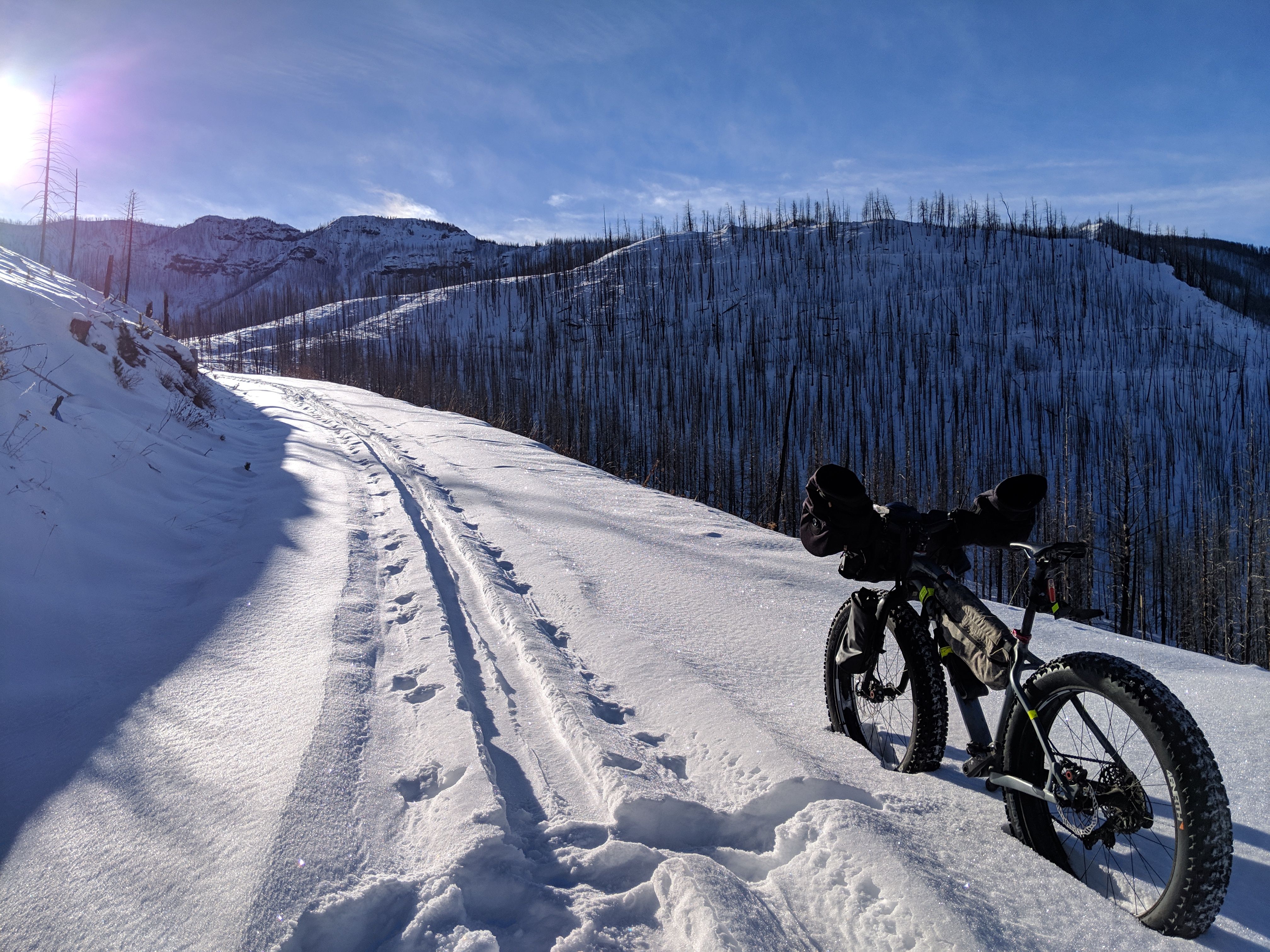Oh That's Cold! A Cold Weather Mountain Biking Guide
Cold weather mountain bike riding can be a blast, but it is important to be prepared with the right gear and knowledge. In this guide, we will cover everything you need to know about winter mountain biking. We'll start by covering some of the basics such as preparing your current bike for winter conditions, and what clothing to wear when riding in cold weather. Next, we'll discuss choosing your mountain bike for winter and fat bikes and how they work so well in snowy conditions. Finally, we will talk about riding ideas and finding some winter trails!
What Temperature is Too Cold For Mountain Biking?
As a rule, there is not a temperature that is too cold for mountain biking. Your preparation and your body's capability are the main limits to enduring cold. First, what are we talking about when we say "cold weather"? Mountain biking is a global sport with global winter weather. Even in the United States, "winter" riding can be vastly different. For this article, I'm going to stick with sub-40F to sub-zero when talking about cold weather. Cold enough to start causing issues with your extremities and bike, down to life-threatening and truly thrilling temps. Winter also tends to bring more moisture to deal with, in the form of rain or snow and everything in between.
Related: Can Mountain Biking in Cold Weather Hurt Your Lungs?
We'll start by saying that there is no definitive answer to this question. For the average person most cold weather will not hurt your lungs, but the dry air at colder temps can cause inflammation with regular high exertion. This increased effort can lead to fatigue and even respiratory issues if precautions are not taken. Also called "Nordic Cough" the drier air in winter can cause lung inflammation and produce a chronic cough, especially in winter athletes who may race in the cold. For an average rider, we recommend trying a light face covering like a Buff which will moisten the air you breath, reducing intensity or pausing intense outdoor workouts in the cold if you experience a regular cough, and definitely get a pulmonary function test done if you experience ongoing issues. Smaller athletes may be more susceptible to chronic issues due to smaller lungs, especially in women.
Can You Ride a Mountain Bike in the Snow?
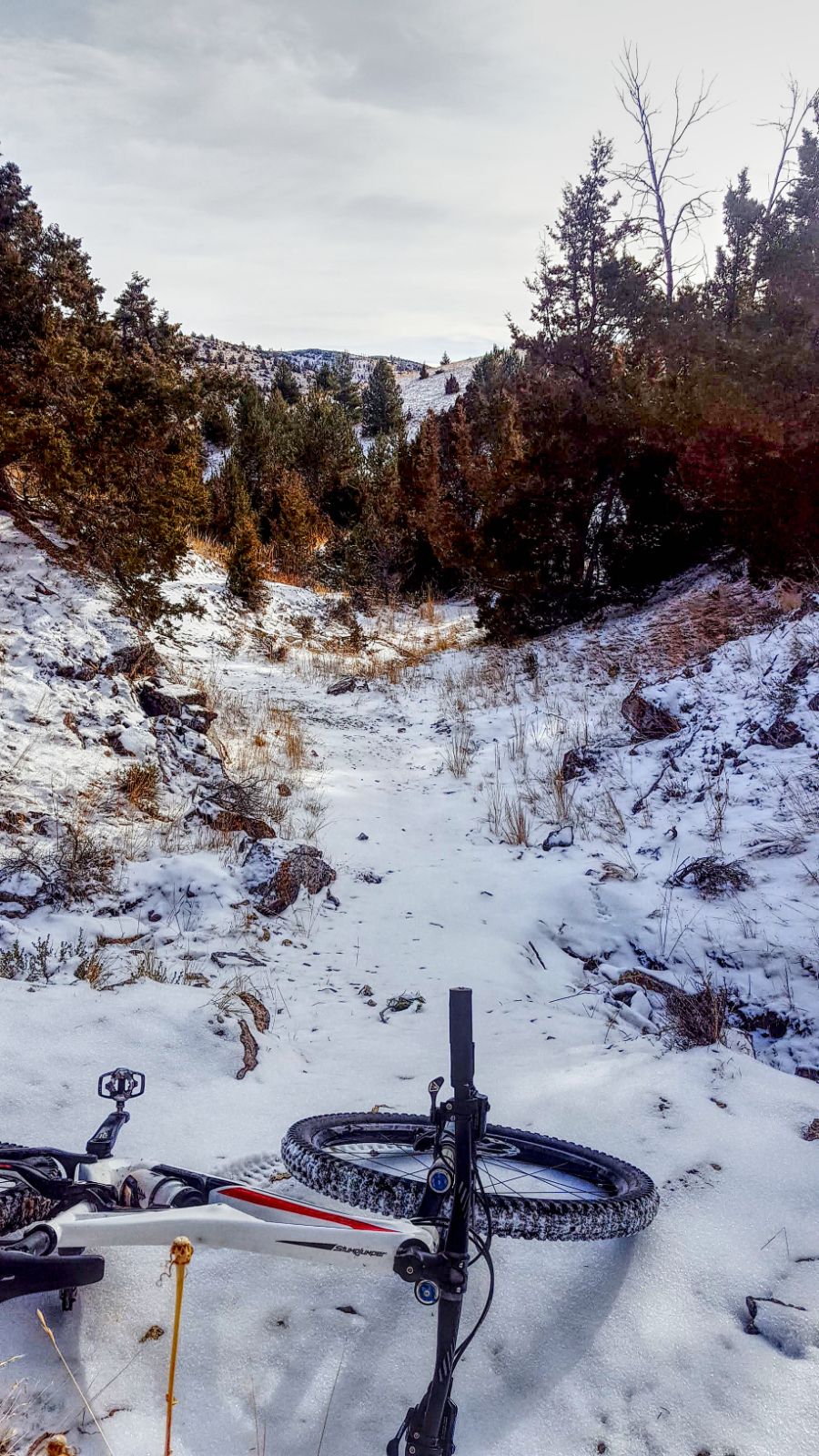
For context, I ride year-round in the Rocky Mountains of Montana. I love winter, I also ski nordic and backcountry, do winter camping, and have done some winter fatbike racing. Sometimes I'm on my full-suspension mountain bike in single digits and sometimes I'm riding my fatbike in snow and negative temps for overnight trips.
As a whole, you can ride a mountain bike in up to about 3" of snow but may want to consider a specialty fatbike for mountain biking when the snow is deeper than that. Some trails are only open to bikes with wider than about 3.8-4", in other words, a fatbike.
Your Bike May Hate the Cold, Getting Your Bike Ready for Winter
Let's start with your current bike, regardless of what type of bike you have there are some component and maintenance considerations.
Different Maintenance in the Winter
Anything with air pressure needs to get checked before you ride. This includes tires, shocks, and your dropper post. Air volume changes with the temperature. This is especially tricky if you keep your bike inside where it's warm. As soon as your bike cools off significantly, it may ride differently or not be ride-able at all. I've driven to a remote trailhead before discovering that my shocks were close to bottoming out just on sag and my dropper post wasn't functioning at all.
If you have suspension, it is most likely air-based, you'll need a shock pump to ride in the winter. Carry it in the vehicle or with you on the first typical winter day in your area so you can increase shock pressure back to what you need. This may also help with a dropper post. I've experienced shock pressure issues in the 30Fs, but usually have only needed to add air once for the winter and then reduce it in late spring.
Oils become sludge, you'll want thinner oils and greases for really cold weather. I bike down to negative single digits and usually just use a thinner chain oil and fresh grease at the start of winter. For sustained negatives, you may need to repack your derailleur and other greased components with a lighter-weight grease. For muddy to super cold, avoid dry or wax lubes. They will stop functioning as it gets cold. Use wet lubes instead.
Tires deflate and sealant dries up. Tire pressure is a little more obvious, but again make sure to check pressure after the bike cools off. Tires can easily go from being fully inflated to riding on the rims in the winter. If you are riding a tubeless setup, at the start of fall or winter, replenish your sealant. If your sealant isn't already dry from summer the colder, dry temps will suck the remaining moisture out. Also, your tire rubber will contract in the cold so the bead may need additional help staying sealed. For extreme cold, consider using tubes. I love tubeless, but my fatbike is set up with the lightest tubes I can find. I've beaten many better riders in fatbike races because their tubeless setups failed in the cold and I was riding tubes. At the least, make sure to allow new tubeless setups to set up well before putting them to the test in extreme cold, don't set them up the night before a bikepacking trip or race.
Components that Require Special Consideration
Dropper posts are awesome in the summer but can fail you in cold temps. I love my Fox Transfer posts for the moderate temp months, but they consistently fail under 20F. By fail I mean they will not stay down or up, this has happened on a couple of different ones and some that were new or recently serviced. This seems consistent with a lot of posts. I've had friends with similar "infinite" droppers that have had the same problem. Dropper posts with set positions tend to fare better, Specialized Command Post, etc. The best are rigid posts, my fatbike will never have a dropper post.
Traction becomes even more important in the winter. Mountain bikes already obsess about tire treads and rubber. Unlike the summer where there are good reasons to consider the trade-offs of lower profile treads and harder rubber, in the winter you want soft, fairly knobby, and probably wider tires. You also won't get away with worn tires, regardless of the tread or width.
Softer rubber which is also tackier, will stay more pliant in colder temps and stick better to slicker surfaces. Maxxis Super-tacky or MaxxGrip compounds may seem excessive in the summer for some, but these should be standard considerations in the winter. Some specialty brands like 45NRTH tend to use softer compounds as a matter of course.
Knobbier tires will handle soft and deeper snow better, but rolling resistance is still an issue if you ride packed surfaces. I like treads like the 45NRTH Dillingers on my fatbike which are mid-aggressive tread but have wide center tread blocks to scoop when digging. For mountain bikes, the Maxxis DHF, Assegai, DHR, and Highroller all do well, as well as the Specialized Butcher.
Tire width in the winter isn't a done deal. Wider tires will give you better flotation if they can be aired down with the tread flattened out. However, in cases where it's muddy or the snow is shallow enough to dig through to dirt, narrower tires will grip as good or better. In mud, a wide tire will float more and not dig down for better grip. If there is just an inch or two of snow I like my 2.5" wide DHFs as much as my 4.8" Dillingers. For deeper snow or where there's packed/groomed snow, then wider is better. Most winter groomed trails will require a 3.8" or 4" tire at a minimum.
Studded Bike Tires
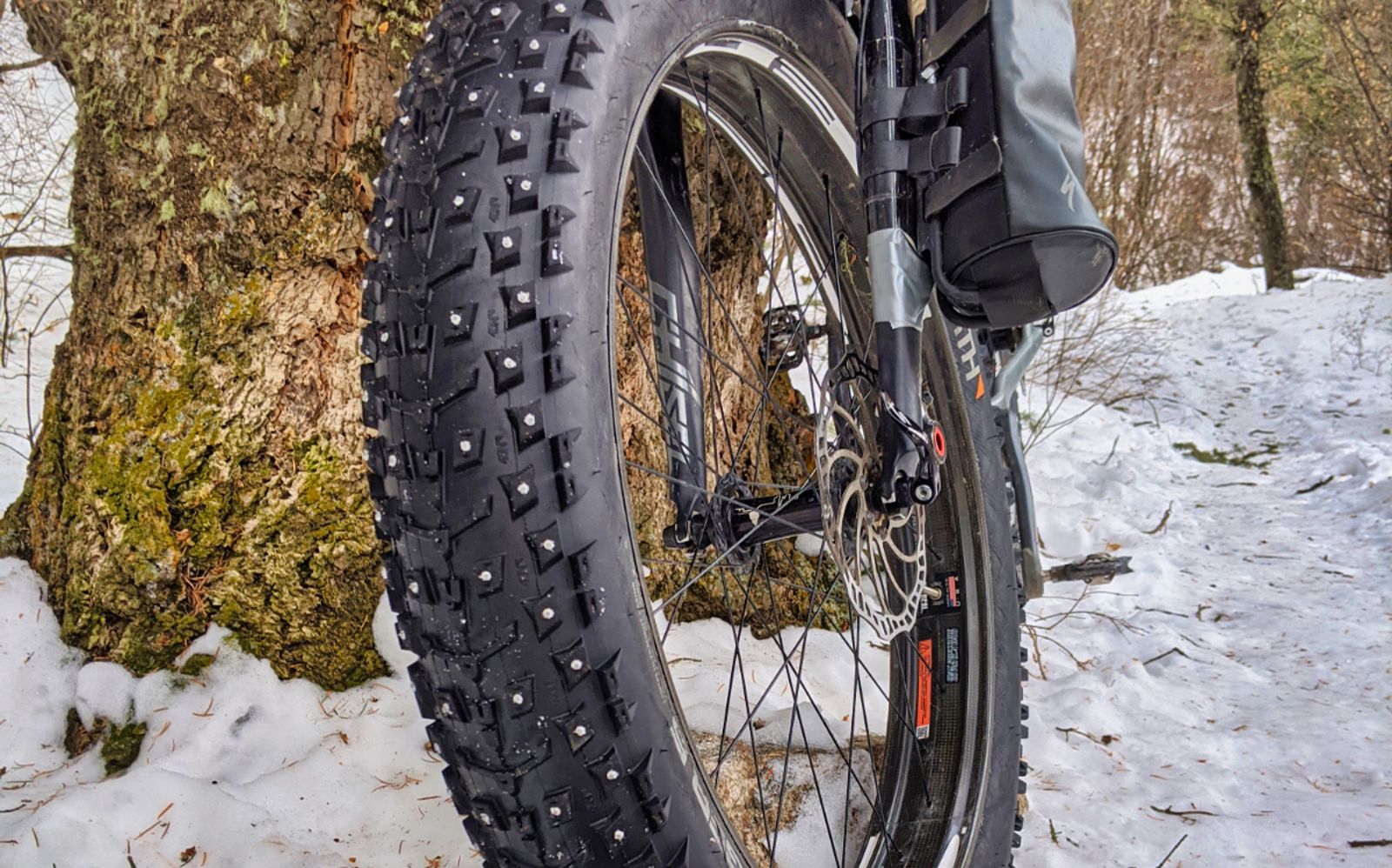
If you can afford the initial cost of studded mountain bike tires, go for them. At least if you encounter ice or an icy hardpack. Studded bike tires, especially fatbike tires can be really expensive. However, falling on ice with a bike is completely unlike falling any other way. With only two small contact patches on ice, you can easily dump your bike with only one tire hitting ice. Unlike the summer, if you put your feet down, they probably won't help you, because again... ice. You will land up cruising along to flat on hard ice with bruised ribs before you register what is happening.
If you are mainly trail riding and not commuting, you may not need studs. In the middle of winter, I am mainly on packed snow and don't need studs unless I'm biking open roads to the trails. At the edge of winter or routes that have a lot of sun exposure is when I run into the most ice. That is going to be region-dependent though.
45NRTH sells several tires for both 29er, 27.5, 26 for regular widths to fatbike widths. I've put around 2000 miles on my Dillinger 5s and the studs and tread are still great. I hated spending the money, but after going through multiple recoveries from wrecking on ice it was worth it. Although I only run my studded tires when there's snow in the mountains they still see pavement and rocks frequently.
Don't Freeze Your Keister, What to Wear When Mountain Biking in Cold Weather
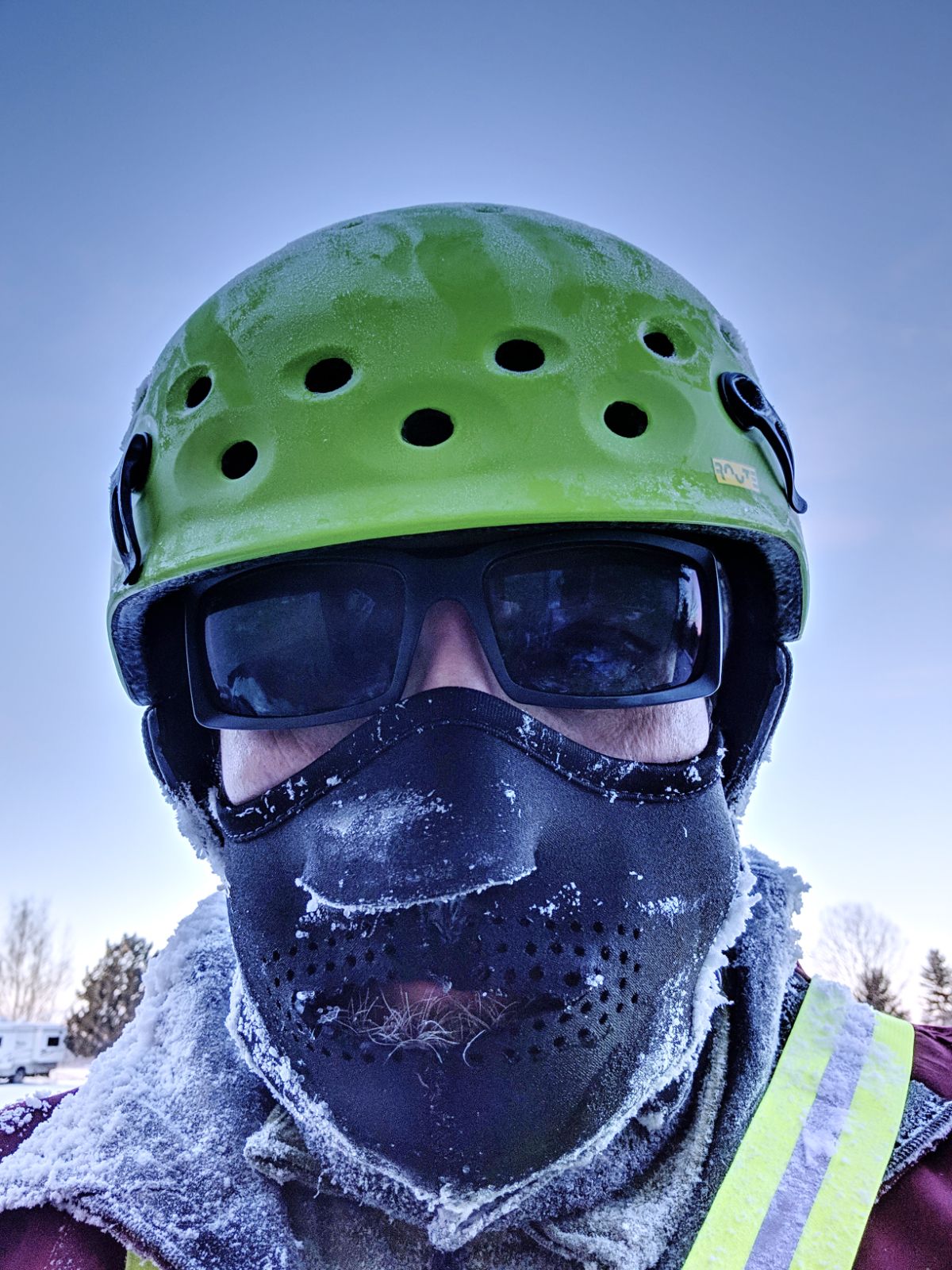
The key for winter mountain bike clothing is to dump heat when pedaling hard and trap heat when you are not. In the winter you will still sweat a lot, and biking has special considerations versus other sports like running. When winter cycling you will go between periods of working hard, like climbing a hill or working a technical section of trail, to periods of low or no effort that generate wind like coasting down a hill. This is no matter what the temperature. Some of your extremities like your hands or feet won't get as much circulation as they would for running or hiking. You'll need to layer carefully for the expected weather.
If you are already a Nordic/XC skier, a backcountry skier, or an avid winter hiker, good news! You probably have most of the clothing you need. If you don't already do a winter sport there are some keys you want to keep in mind.
- Layer with a base, mid, and outer shell so you can adjust your warmth as you work out.
- Moisture is your enemy, moisture that you both generate and that the weather throws at you. Only wear synthetics like polypropylene-based fleeces or natural insulators like wool and feather down, never wear cotton. Poly/wool blends tend to work best, unlike cotton, these will still insulate when damp and dry easily. Even a cheap poly fleece is superior to the most expensive cotton clothing. In the backcountry, the saying is "cotton kills".
From the top-down, for winter biking you should wear:
Head
You still need a helmet, depending on conditions you may be more likely to crash. From personal experience, ice hurts to fall on. Balaclavas, Buff headwear, and scuba-style hoods from your base or mid layers all work well to fit under helmets. When things are warmer than 20, I like wearing a Buff on my head and one around my neck with a hooded base layer as a backup. The neck Buff can act as a great face covering on the downhills. For colder temps, I'll upgrade to a wool/poly blend balaclava and fleece or micro puffy jackets with hoods. For very cold or wet conditions I also make sure my jacket shell has a hood that can fit over my helmet.
Core
As already mentioned, it's all about layers with hoods. Especially "scuba" style hoods. If the hood is too loose-fitting it'll bulge out under your helmet and not protect enough. You always want a base layer, a mid-weight layer, and a shell for blocking wind and moisture. The thickness, or the number of layers should be adjusted based on your cold tolerance and the weather. I recommend more layers instead of thicker layers. This will keep you more adaptable to high efforts or changing weather. For example, for single digits and colder I wear a mid-weight fleece and pack a thin puffy jacket to throw on and off along with a ski jacket and light base layers. My jackets all have pit zips to allow airflow to keep from getting sweaty. I also make sure my mid and outer layers zip up enough to cover my face in case I forget a face mask or the windchill is bad. Gore-tex backcountry ski/climbing shells work well, however, all the major brands have their water-proof breathable alternates that are cheaper and as good.
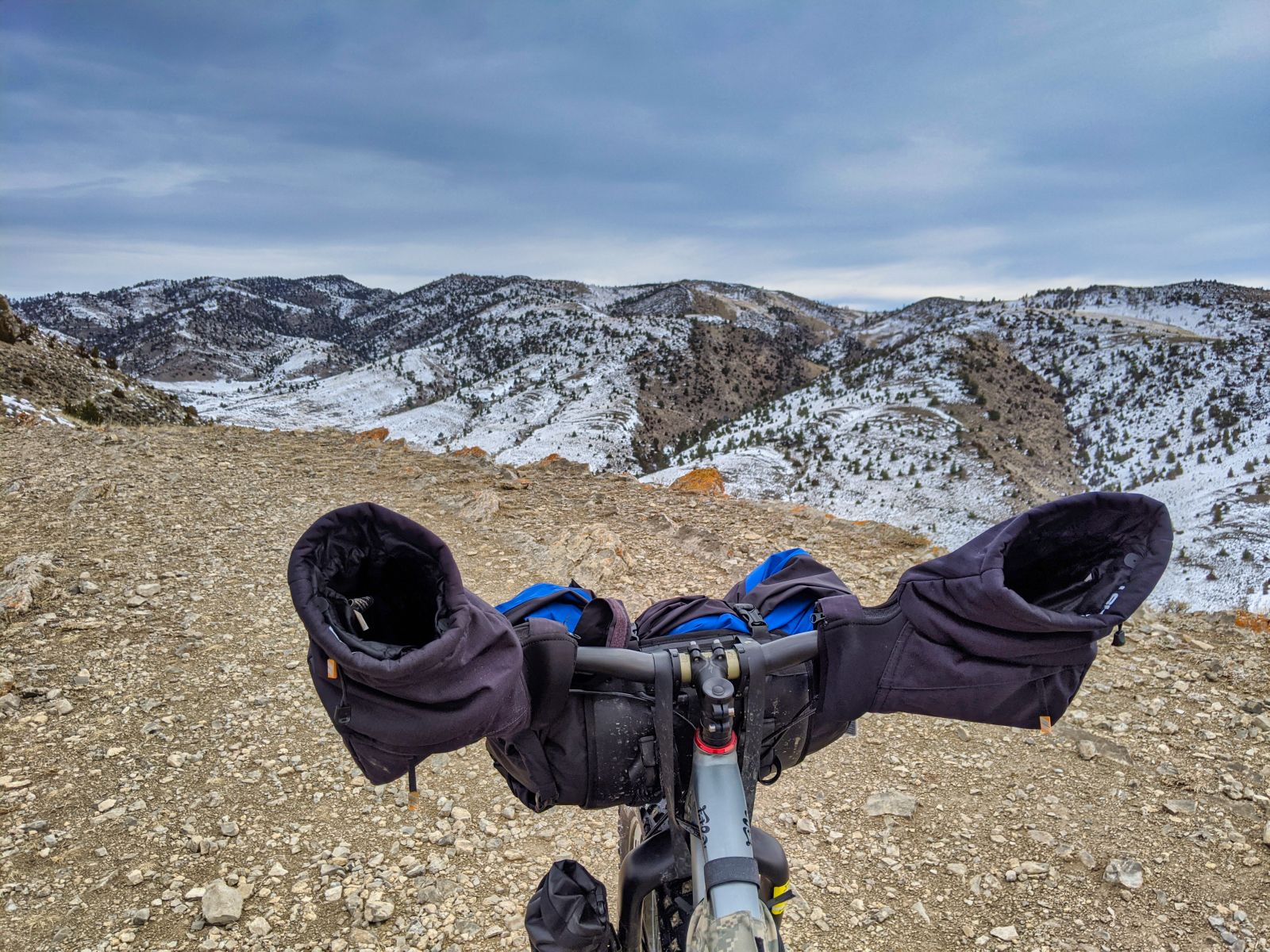
Hands
Hands can be tricky, you do not work your hands much while biking at times, and other times you do, at least you may work your arms. When temperatures are near freezing or colder, always bring two pairs of gloves. Bring a light pair for when you are working hard, and a heavier wind-blocking pair for easy sections. If your hands get cold, they will not likely warm up on the bike until the next high effort section. So proactively switch your gloves, take off your heavy gloves before you sweat and get them wet, and put them on before your hands get chilled.
Ski gloves work great, they tend to be waterproof and handle the wind. If I'm not using my pogies (see next) I switch between light-weight fleece gloves and some Black Diamond ski gloves or mittens if it's extra cold. At least when I started fatbiking in the winter. Later on, I moved to using pogies in the winter. If you buy a new pair of gloves for winter biking, I recommend getting gloves that can fit under your jacket cuffs. I usually prefer gauntlet style, but on the bike, your arms are always pointing down and gauntlets act as funnels in wet weather.
The right pair of pogies are awesome and super adaptable to weather. A pogie is a "bar mitt", a kind of insulated cover that goes over the end of your handlebars allowing you to insert your hands and forearms into them to your bike grips. I have the 45NRTH CobraFists and usually only wear some thin fingerless road gloves down to about -5F. The CobraFists have vents that allow me to cool them off when it's warmer. They also have little inside pockets to keep my snacks warm or keep maps for adventure racing in the winter. There are lighter ones from both 45NRTH and Revelate Designs as well. They make your bike look like a moose, but are awesome for really cold mountain biking.
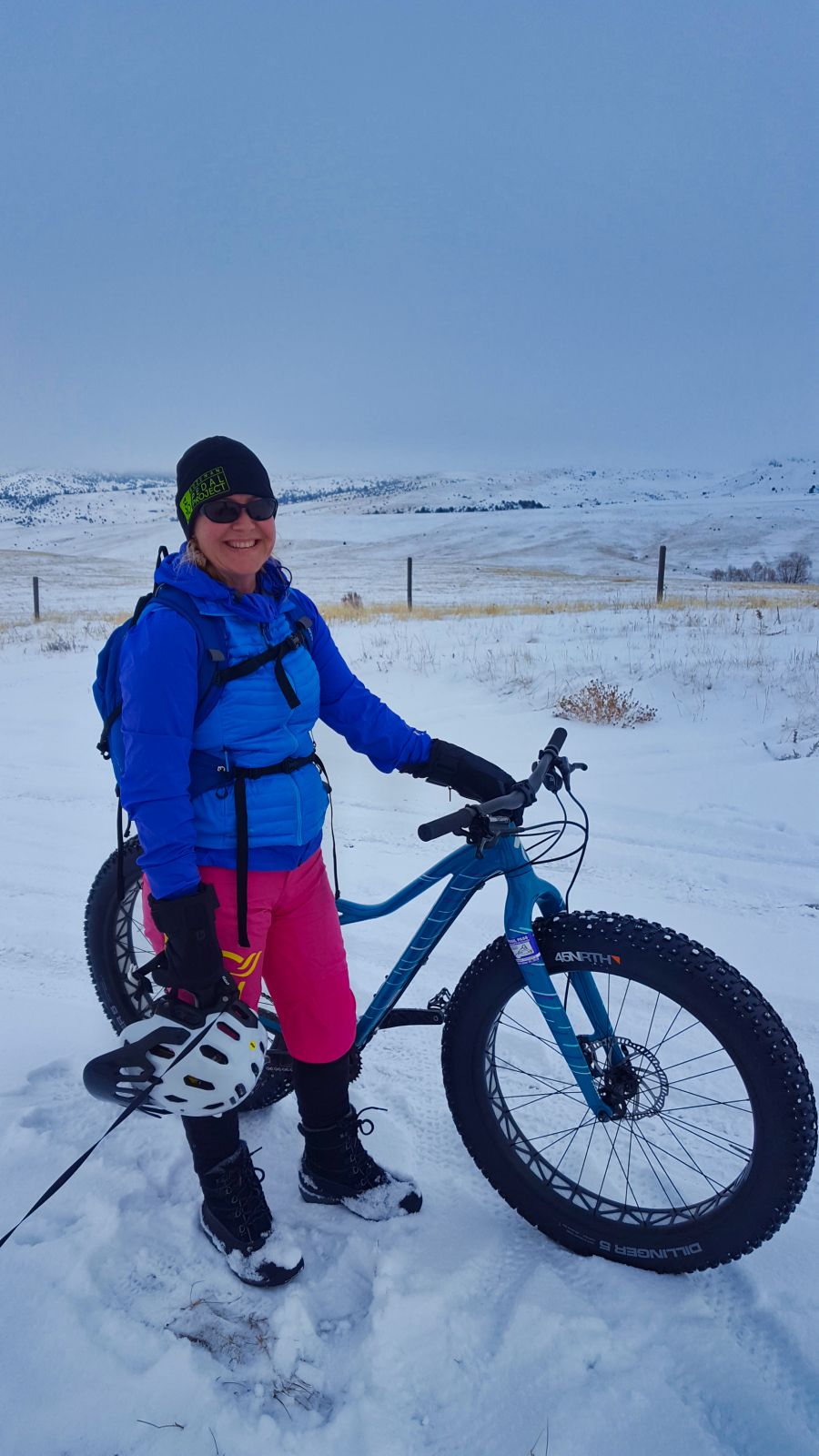
Legs
Pretty similar to your core. I can usually get away with a light to heavy base layer and then a shell or softshell. Shells with full zips are awesome for winter, they are easy to adjust your warmth based on how much heat you're generating and are also easy to take on and off. That last part is key, ease of putting them on and off will encourage you to change more often instead of waiting until you're already cold or sweating. For 20F+ I typically use a mid-weight tight/thermal with water-resistant softshell climbing/hiking pants or baggy bike shorts and gaiters. I like the shorts and gaiters with rain pants when it's that warm or for days that are going to change temperatures drastically. For sub 20F I wear some form of ski shells and fleece base layers.
Feet
Feet are personally the hardest for me to keep warm. I have done every trick and tried every style of bike footwear to push how cold I can ride. For barely freezing and above you may be able to use your normal bike shoe with warm socks as long as they're not too ventilated. I sometimes switch to some full leather hiking/approach shoes or hiking boots that are roomy enough for thicker socks. Lately, I've been using Pearl Izumi Amfib shoe covers for my regular mountain biking shoes with success. I have their soft shell toe covers which work down to the 40s and then their insulated AmFib shoe covers into the upper 20s. I like the covers in the edge seasons since I can remove them as the day gets warmer. Temps in the Fall and Spring vary so much, I like using covers over buying additional specialty shoes. If you ride in a lot of wet weather Gore-Tex shoes may work well, but make sure the outer layer won't soak up water. Gore-Tex only keeps water from your foot, but your foot can feel like it's in an ice bath if the outer material is soaked in cold water.
For colder temperatures, you'll need to move to insulated boots, either insulated pack boots like Sorel makes or specialty boots like the 45NRTH Wolvehammer and Wulfgar. No matter what you try, the key trick is to size up for biking. Getting a bigger boot than you normally wear will allow you to add thicker socks or multiple pairs of socks. I like to size up by 1 in US mens when I can.
If your feet still get cold, try getting some chemical foot warmers. These are little packs that activate with air and stick to your toes. I've had varied success with them, you need to allow enough air around them for them to get warm. Another trick that has worked wonders for me is to use a vapor barrier. No matter who you are, your feet are one of the sweatiest parts of your body. This sweat hurts the insulating quality of your footwear. A vapor barrier blocks the sweat from getting to your insulation, keeping it dry. It feels a bit counterintuitive because your feet will be super wet, but it works. I wear a thin merino wool sock, a plastic grocery bag (no single-use here!), and then my heavy wool socks and boots. My feet don't feel wet until I take them out at the end of the ride, but they stay much, much warmer.
Extra Gear You'll Need for Cold Weather Riding
To summarize for warmth the extra gear you may need for winter mountain biking are winter clothing, footwear, gloves, pogies, and chemical feet/hand warmers.
Extra Storage
Beyond warmth, you may need a backpack or frame bag for the extra warmth you are carrying. Frame bags are just bags that fit into the frame triangle of the bike. You may already have a big enough mountain biking backpack, but in the winter you also have additional considerations like winter layers, and essential survival gear. On my trail or enduro bikes I'm using a 18L sized CamelBak
Survival Gear is Even More Important
Essential survival gear in the winter becomes more vital. In the summer you may get away without packing a fire starter, but in the winter it is much riskier not packing the 10 essentials. I always carry an emergency bivy with me that can act as a water barrier and shelter.
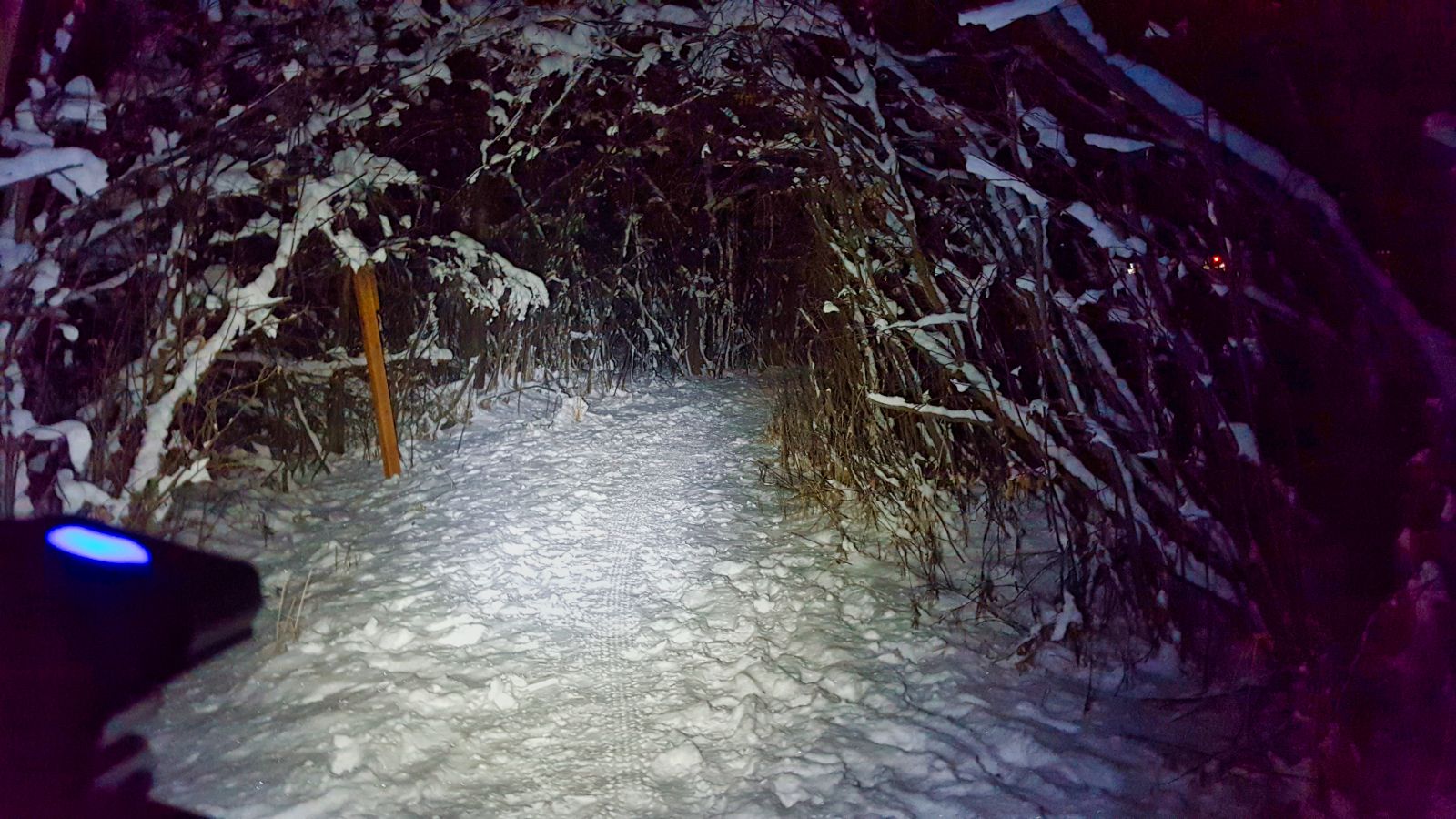
The Night is Dark and Full of Terrors
Not really, it's a blast and peaceful while all the other apes are hiding in their caves.
Lighting becomes more important in the winter. For many of us, the days are much shorter or we have to bike in the dark outside of our work hours. Unlike when things are dry, I find lights reflect and light up the terrain much better in the snow. You may be able to use an existing headlamp instead of springing for a powerful bike light. Make sure your batteries are newer, you may want to switch to lithium as well. Batteries wear down much faster in the cold, lithium is more cold resistant. Lights with separate battery packs that can go in a jacket work well, but I've been fine in single negative digits with my Nightrider lights (1000 and 750 lumen versions).
Fat Bikes, Mountain Bikes and Winter Riding
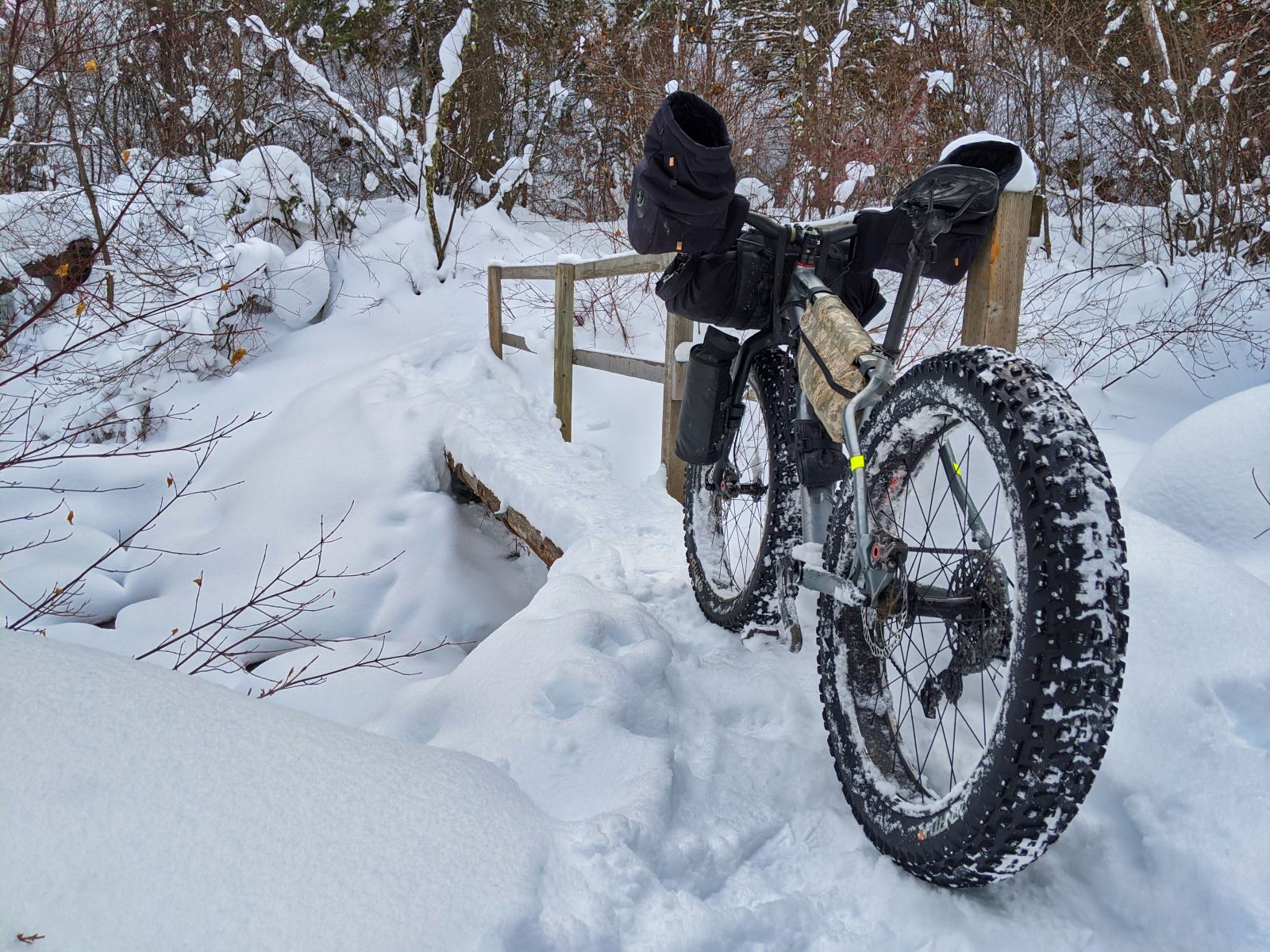
The type of bike you ride for winter comes down to what you want to do and what the winter conditions are in your area. Even in Montana, we have high arid desserts that get very little snow some winters, I've been fine riding my regular mountain bike with summer knobbies in January at Copper City. Closer to the mountains I could ride gravel roads much of the winter, but to get out on trails I need my fatbike.
We will cover a more thorough article just on fatbikes, some of us have been riding fatbikes for around ten years. Some winters I have clocked around 800 miles on snow with my Specialized Fatboy SL.
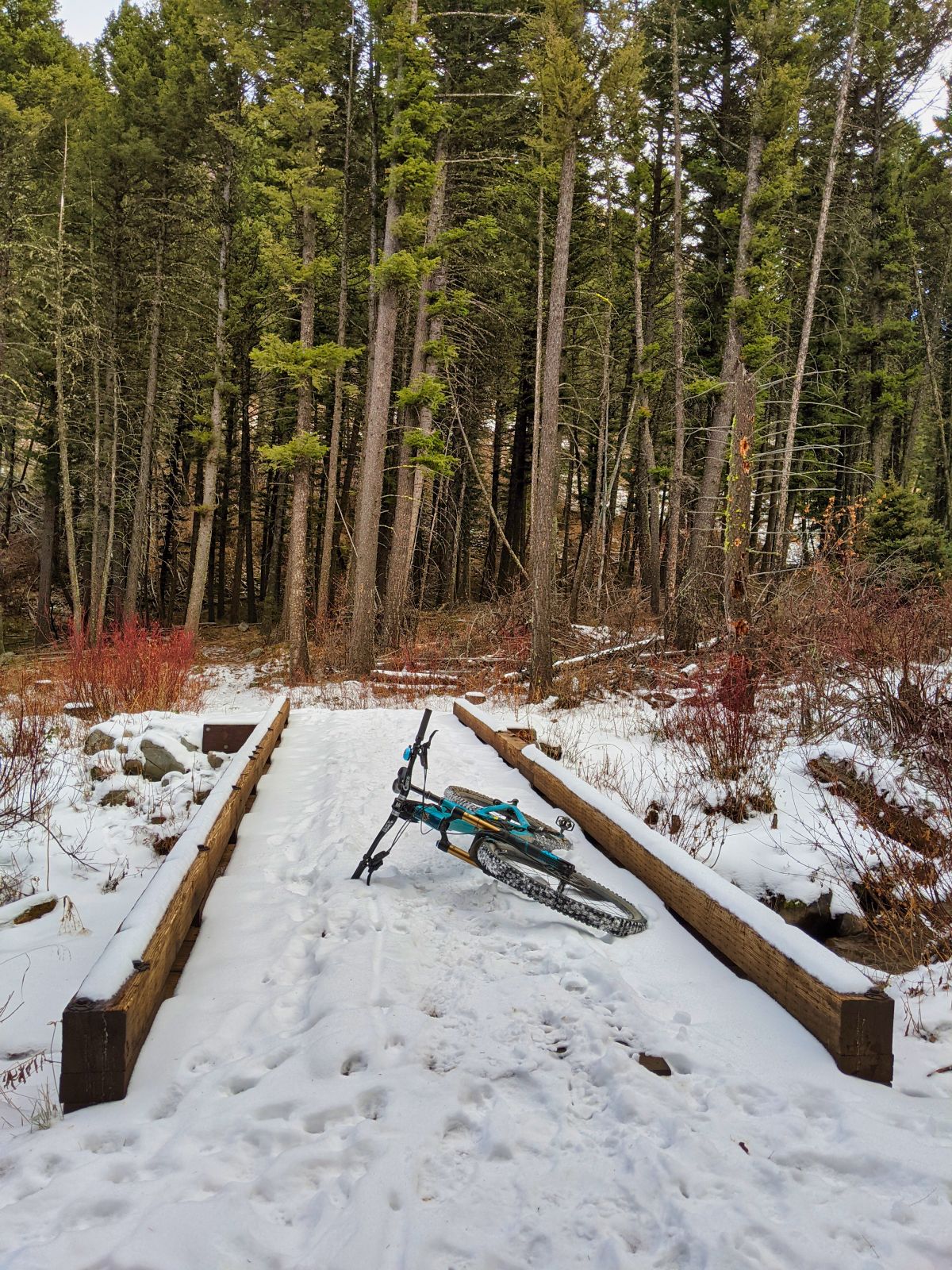
On trails I can ride my enduro and trail bikes with Maxxis Assegai MaxxGrip (2.5" width) up to about 2-3" of snow, depending on how heavy the snow is. As long as there isn't old packed down ice underneath it's a lot of fun and grip is good. Above that amount, or with a thick packed surface I break out my fatbike with studded 45NRTH Dillinger 5s.
Factors if you are considering a fatbike:
- Find a rental shop first if you can. This is true of any bike, but fatbiking is completely different than summer mountain biking. In the shoulder seasons, you'll be able to keep riding single-track as you would in the summer, but once the deep snow comes you'll be dependent on other trail users packing the trails.
- Most groomed trails don't allow bikes with tires under 3.8-4" of width, plus it's rude to create ruts on ski groomers. If you have groomers in your area that allow fatbikes, you'll get a lot of mileage in riding all winter. More areas are getting fatbike clubs that are grooming single track.
- Snowmobile trails make for great fatbike trails. I only need a couple of snowmobiles to have set a trail before they are rideable. Just be sure to check if any permits are needed, in Montana a trail pass is required for snowmobile groomers. The fees go towards the clubs that do the grooming.
- Fatbikes are usually really simple component-wise. For winter you don't need front suspension at all. Since they tend to be simpler, they also tend to be cheaper and easier to maintain. Even high-end brands offer their base fatbikes in the sub-$1000 range. Since fatbikes might not see the same type of abuse a summer bike gets, used bikes can be a great option.
Final Tips for Riding in Winter Weather Conditions
Mountain Bike Tire Pressure in the Snow
For any biking in the snow, you will need to adjust your tire pressures based on conditions and your tires. There isn't a single tire pressure for snow, but usually, you will be under 18psi on a regular mountain bike tire, and probably under 10psi for a fatbike tire. Bigger volume tires can handle and benefit more from lower tire pressures. The softer the snow, the lower you will need. The most important indicator is how your bike is riding and how deep of a rut are you leaving. If the front tire is wandering or feels like it can't keep a straight line, you need to drop tire pressure. If you are leaving a significant rut in packed snow, then your pressure is too high.
In the other direction, if you are floating well and your tires are tracking well, but it feels like a lot of effort to pedal, you may want to add tire pressure. Another consideration is if you are on a lot of ice and have studs. You want to concentrate more weight on the studs that make contact with the ice to dig in better. Fatbikes are good at distributing weight across a bigger contact patch, but for grip with the studs that isn't necessarily a good thing. On my bike, it is about break-even as long as I don't keep lowering pressure beyond my outer rows of studs making contact with the ice (see the above picture under Studded Tires).
Water and Hydration
Cold weather is deceptive when it comes to hydration. You will still sweat a fair amount but not notice it as much with good layering. You need to still pay attention to staying hydrated, and you may be working your muscles even harder in the snow. I use the same electrolyte and fuel mixes in the winter than I do in the summer (Hammer Enduralytes).
The biggest challenge with water is keeping it from freezing. For moderate freezing temps bottles work okay, but will slowly freeze. Water bladders are excellent, but the hoses freeze fast, even with some of the neoprene sleeves. The next best are packs that run the hose inside a sleeve in the shoulder strap, with ZERO hose exposed. Camelback and Revelate Designs have made hydration packs for winter that do a decent job. However, I find most packs only keep the water thawed down to about 10-15F. The best solution is to have a slim hydration pack that will fit under your mid-layer and shell. I have only been biking down to -10F with about -30 windchill, but so far my water has stayed thawed in my Camelback ski hydration pack under my layers.
The last hydration tip is to use hot water. Starting with hot water will keep it from freezing for quite a while. If you can keep the container under a jacket or wrapped up inside a pack, it can withstand cold weather.
Food, Eat Like a Bear
For biking in the winter, I still make sure to pack calories. In the winter I move to fattier snacks like nut bars or trail mix. This is a trick from winter backcountry trips, fattier foods work the digestion more and in turn, get your body to warm up more.
If you are planning on long days, it would be a good idea to invest in a small backpacking stove to melt water or heat food. Besides being a great survival tool, having a hot lunch or hot cocoa does wonders for the spirit in winter. Some multi-day races, like the Fat Pursuit, require water boil tests even at the start of the race to qualify.
Watch Out for Rides With Climbs/Descents
When starting, try to find routes that are flatter or will have an even workout throughout the entire ride. Avoid starting winter biking on routes with long climbs and descents until you get your layering dialed. Don't underestimate the routes that you ride in the summer.
Sweating up a long climb may lead to hypothermia and frostbite coasting back down. I have had to go from climbing with only my base layers on the way up to wearing everything plus a mask on the way back down.
Start small
As with most things related to outdoor activities, always start small based on a realistic review of your experience. If you are already an avid cyclist, you will want to dial back your first rides to get experience with layering and keeping your water thawed. If you are already experienced in backcountry snow travel then you can plan on more.
As you gain experience you will get better at picking your routes and layering for different temperatures and conditions. Just remember in the summer you have a lot more room for error than in the winter. If you get chilled it may only take minutes to go into hypothermia or get frostbite. Be realistic and build up your experience over time. Try biking around the neighborhood or sticking close to the vehicle when you are unsure about temperatures you haven't attempted yet.
Where to Ride in the Winter
Dry, Arid Regions
Desserts come in many forms, but arid regions usually get less snow and rain in the winter. This means you may have rideable trails and primitive roads in the middle of winter. Just watch out for thawing conditions as these areas can get ultra muddy very quickly. If it is going to be sunny and upper 20s, ride early to avoid the mud. Besides ruining trails, mud on frozen ground is one of the most challenging surfaces to ride on.
Town Trails
If you are lucky and live near a town that has bike paths, these will often be rideable in the winter. Usually, you don't need a fatbike but might need studded mountain bike tires since town trails get packed down and ice up easier. With snow, usually boring and easy trails can become a lot more fun and challenging.
Bad Terrain for Snow
If you ski, you already know areas that are horrible skiing because the snow is too thin. For biking, these can be perfect! Trails that are lower elevation, like foothills trails will usually get and keep less snow. Trails that get a lot of sun exposure, especially in the afternoon may stay clear. Trails with fewer trees and foliage will tend to lose their snow. Just watch for ice from the freeze-thaw.
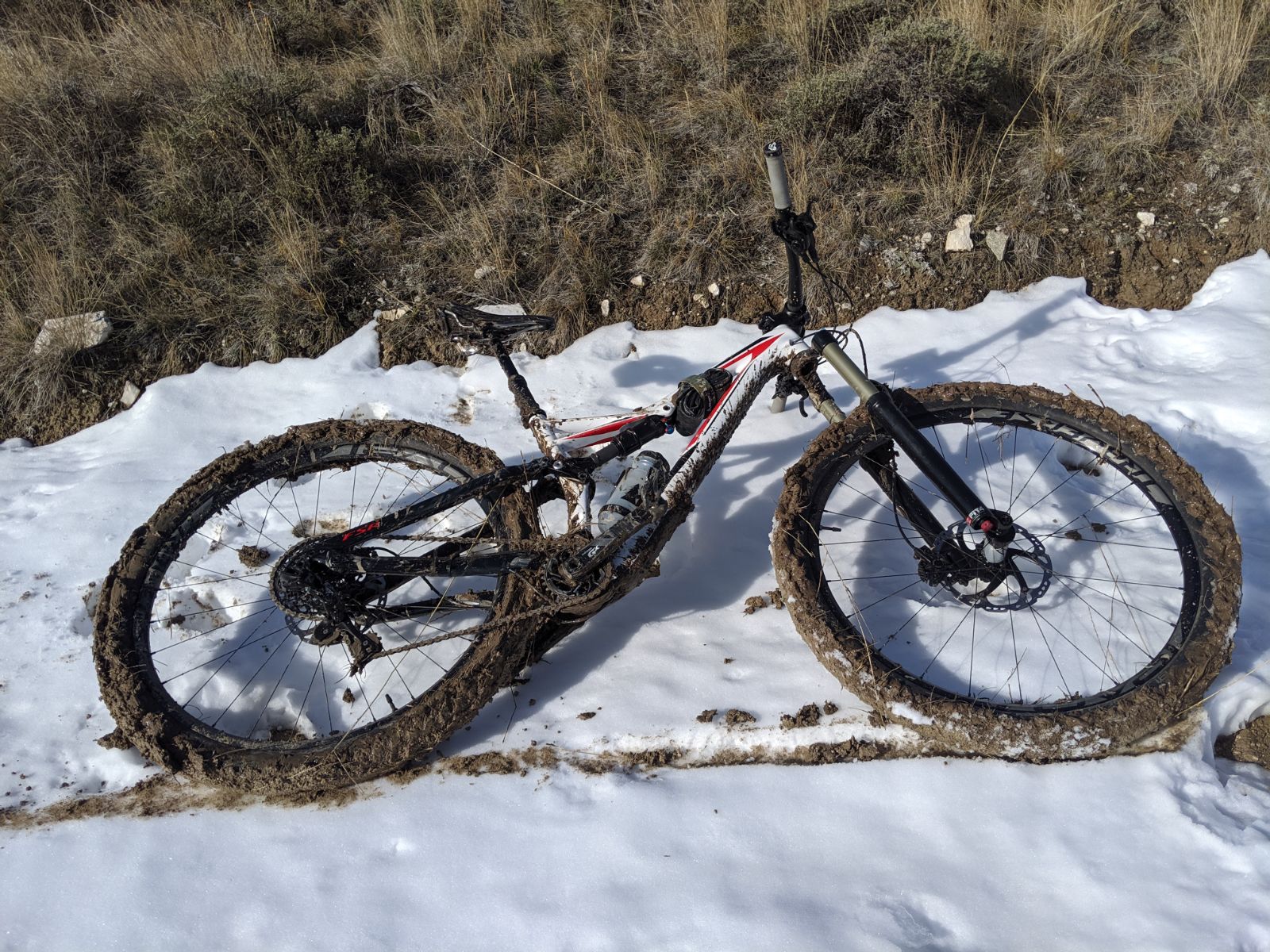
Ski, Snowmobile, or Fatbike Specific Groomed Routes
For fatbikers, check your local groomed trail regulations. Depending, you may be able to ride on nordic or snowmobile trails. In general, when riding on nordic trails: be polite, try to not ride right after a trail is groomed (give it a few hours to setup), avoid the skin track (parallel grooves set by a groomer for skiers), drop tire pressure until you are not leaving a rut, and try to ride to one side. Skate skiers use the center and any ruts can make skating difficult. That all being said, my fatbike leaves barely any rut on groomers when aired down properly, my nordic skis leave more of a rut.
Ski Resorts
Related to groomers, many ski resorts have added fatbiking areas to their nordic ski trails. Check out any local ski resorts that have XC/nordic ski trails. Many will also have fatbike rentals to try out. If you are into racing, many resorts that allow fatbiking will often have races too.
Popular Hiking/Biking Trails
Any trail that allows year-round mountain biking is game for winter riding. Just check any signage at the trail. In the summer I normally avoid popular trails, especially trails with lots of hikers. However, in the winter the popular trails get packed down the fastest. These can create flowy and smooth trails out of the gnarliest summer rock gardens. Embarrassingly a few trails I can only clear the rock garden climbs in the winter when they are buried.
Just like the summer, make sure you can ride under control. That means can you stop for a hiker around that blind corner? Do you have enough traction to stop without crashing into someone? Usually, I'm riding slower in the winter because of the rolling resistance snow creates so other trail users aren't a big concern. Just be sure to be an ambassador for our sport.
Get Out There and Shred!
Winter mountain biking is a great way to enjoy the outdoors when you can't ski or if you just plain love biking. We covered some topics that could make you nervous to ride in the winter, but it is worth it. I am a much stronger skier and summer enduro rider since picking up winter mountain and fatbiking. There is also nothing quite like the peacefulness of riding in snowy terrain.
